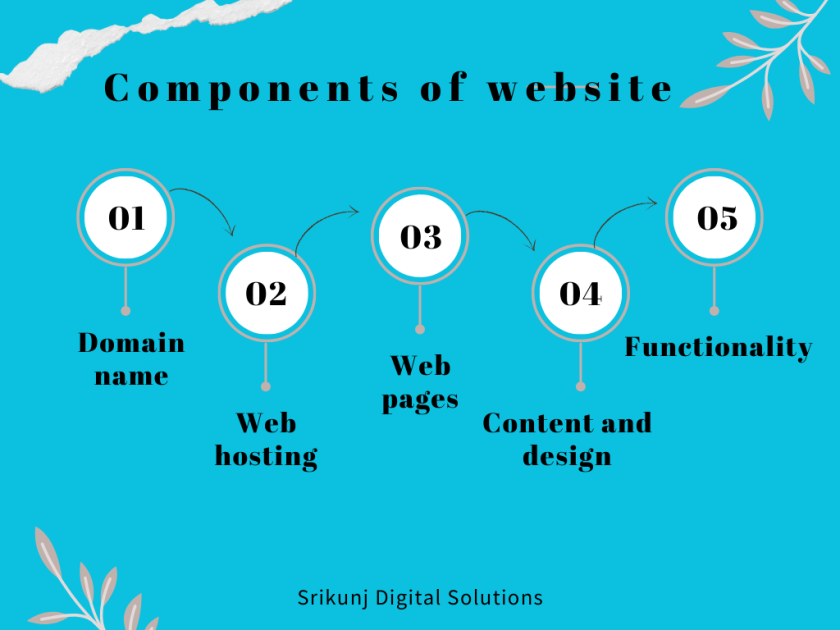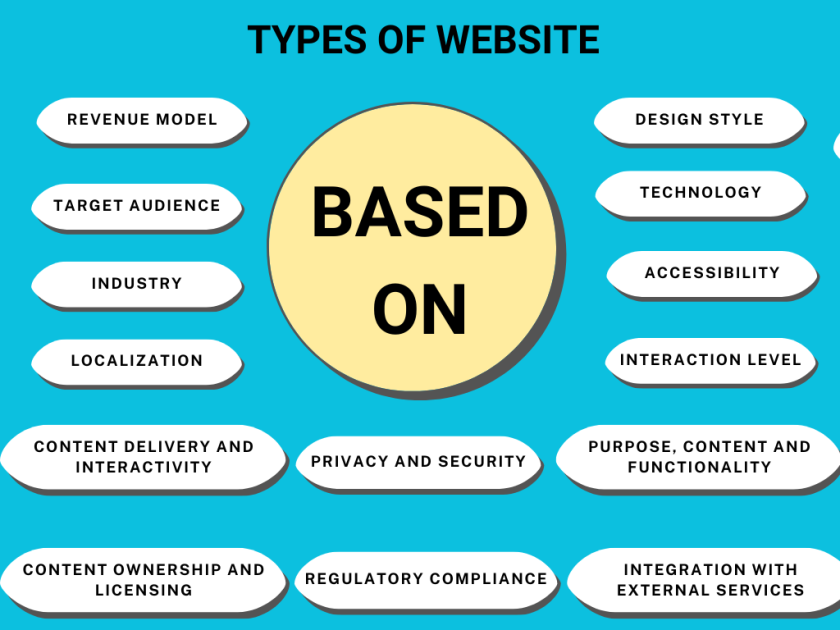What is a website

A website is a collection of many web pages; each constructed using HTML (Hyper Text Markup Language) and WebPages are interconnected through hyperlinks and hypertext, maintaining a consistent interface and design. It will be hosted on a server and connected to the internet 24/7. These servers are commonly referred to as web servers.
A website is an online platform where we can effortlessly share information about ourselves and our businesses or disseminate our expertise. It provides a personalized space on the internet to present our thoughts and engage with others to acquire new knowledge. Accessing a website requires nothing more than a device equipped with a web browser, such as a laptop, Smartphone or tablet and an internet connection.
Components of website

There are multiple terms used to describe the components comprising a website. Here are some alternatives that can clearly describe all the components of websites which will make us understand “What is a website”
Domain Name
Users type this unique address into their web browser to access a particular website. For example, domain names are www.srikunj.org, www.srikunj.com, www.srikunj.in, etc.
Web Hosting
Web hosting is the process of making websites accessible online by storing their files on servers connected to the internet.
Web Pages
These are the individual documents or files containing text, images, videos, etc. They are linked together using hyperlinks to form a cohesive website. e.g., home page, contact us, about us, etc. Among all web pages, the home page is often considered very important.
Content and Design
It contains information tailored to a specific purpose: to inform, entertain, sell products or provide services. Websites often feature a design layout comprising visuals, text, navigation menus and interactive elements.
Functionality
It offers various functionalities, including contact forms, e-commerce platforms, search capabilities and user registration, depending on the purpose and needs of visitors.
Types of website

After understanding ‘what is a website’, we need to understand the types of websites. In today’s digital age websites serve diverse purposes and cater to various needs and interests, providing unique functionalities and experiences. By exploring different website categories and their distinct features, we gain valuable insights into how they influence our online interactions and shape our digital experiences. The expanded list of types of websites categorized based on various criteria is concisely explained to explore what is a website and types of website.
Based on Content Delivery and Interactivity
Websites can be categorized based on content delivery and interactivity in various ways as per their specific goals and requirements. Mostly used are of two types. Static Websites and Dynamic Websites
Static Websites
Static websites are typically constructed using HTML and CSS and of fixed-feature content that remains unchanged over time. They commonly serve purposes such as personal websites, landing pages and brochure sites.
Dynamic Websites
Dynamic websites deliver content that can change based on user input, interactions or database queries. They often use server-side scripting languages like PHP, Python or Ruby. News websites, blogs and e-commerce websites are the best examples
Based on Purpose, Content and Functionality
These categories often overlap, with many websites incorporating these features to serve users effectively. They serve diverse purposes from personal blogs and informational sites to e-commerce platforms and social networks (e.g., Facebook, WhatsApp, Instagram, LinkedIn, etc.), acting as online presences for individuals, businesses, and organizations, enabling them to connect with a global audience. The following are commonly used types of websites
E-commerce Websites
The primary goal is to facilitate online transactions of goods or services for customers. It includes product listings, descriptions, pricing information and shopping cart functionality, which comprises secure payment gateways, user accounts, product reviews and order tracking.
Government Websites
Government websites contribute to transparency, accountability and citizen engagement by providing access to necessary information and services, including permit applications, tax payments, public records access and form filing. Also provides FAQs and contact options for user assistance, feedback submission, public consultations and surveys for citizen input.
Corporate Websites
Corporate websites play a vital role in establishing and maintaining the company’s brand identity and communicating its value suggestions to customers and other stakeholders. Also, providing them with information on products, services and company details. They engage visitors with features like e-commerce, news updates and social media integration.
Personal Websites
Personal websites provide an online platform for individuals to display their work, skills and interests. They feature portfolios, blogs and contact information, allowing for self-expression with others. So that individual can establish their online identity, share their passions and pursue their personal and professional goals.
Portfolio Websites
The Portfolio website provides powerful tools for individuals to showcase their talent, attract opportunities and set up their professional presence online. They provide a platform for individuals to emphasize their skills, creativity and achievements helping them to advance in their career or follow their passion.
News Websites
News websites aim to inform readers about current events across various topics. They provide articles, reports and multimedia content, with features like search, social media integration and personalized recommendations for user engagement.
Blogs
Blog websites are online platforms where individuals or organizations share personal experiences, thoughts and expertise on diverse topics. They include posts authored by bloggers, covering a wide range of subjects, with functionalities for easy navigation, reader engagement and content sharing.
Review Websites
Review websites serve the purpose of providing feedback and evaluations on products, services or experiences. They feature user-generated reviews and ratings to help consumers make informed decisions. Functionality includes search options, sorting features and user interaction tools to make easy navigation and engagement
Educational Websites
Education websites serve the purpose of providing educational resources and making easy learning. They offer various content such as courses, tutorials, articles and interactive training. Functionality includes features like user authentication, progress tracking and discussion forums to improve the learning experience
Social Networking Websites
Social networking websites serve the purpose of providing online platforms for users to connect, communicate and share content with others. They feature user profiles, news feeds, messaging systems and various interactive essentials to facilitate social interactions. Content includes user-generated posts, photos, videos and links, catering to various interests and preferences.
Wiki Websites
Wiki websites enable shared content creation and editing by users. They offer information on various topics and allow individuals to contribute and update content. Users can easily edit articles, monitor changes and engage in discussions with others.
Forums
Forum websites are online platforms for discussions where users can converse, ask questions and exchange information on diverse topics. Discussions are organized into threads by categories, user can post messages and respond to existing discussions. Content includes user-generated posts, comments and discussions covering various subjects. Functionality includes user registration, search features and moderation tools to enhance communication and community interaction.
Based on Industry
These types of websites are found virtually in every industry, each tailored to meet the specific needs of its target audience. Some important types are explained here.
Travel Websites
Travel websites cater to the tourism and hospitality industry, providing users with tools and information to plan and book their trips. They offer services such as flight and hotel bookings, travel guides, destination reviews and journey planning tools to assist travelers in organizing their journeys efficiently.
Art and Design Websites
Art and design websites cater to the creative industry, providing platforms for artists, designers and enthusiasts to showcase their work, connect with audiences and explore ideas/inspiration. They feature portfolios, galleries, tutorials and forums, serving as hubs for creativeness, collaboration and innovation in various artistic disciplines.
Fashion Websites
Fashion websites are dedicated to the fashion industry, offering platforms for brands, designers and retailers to showcase their latest collections, trends and products. They provide shopping experiences, fashion news, style tips and inspiration to fashion enthusiasts, enabling users to immerse themselves in the world of fashion.
Sports Websites
Sports websites cater to the sports industry, providing platforms for fans, athletes and organizations to access news, scores, analysis and other content related to various sports. They offer coverage of events, player profiles, statistics and fan forums, serving as hubs for sports enthusiasts to stay updated and engaged with their favorite teams and athletes.
Food and Recipe Websites
Food and recipe websites cater to the cooking industry, providing platforms for chefs, home cooks and food enthusiasts to explore recipes, cooking tips and cooking inspiration. They offer a wide range of recipes, cooking tutorials, ingredient guides and restaurant recommendations, serving as hubs for individuals to discover and share their love for food.
Gaming Websites
Gaming websites cater to the gaming industry, providing platforms for gamers to access news, reviews, guides and other content related to video games. They offer reporting of gaming events, player discussions, tutorials and game recommendations, serving as hubs for gamers to stay updated and engaged with their preferred games and gaming communities.
Health and Wellness Websites
Health and wellness websites cater to the healthcare industry, offering online platforms for individuals to access information, resources and tools for maintaining and improving their physical and mental well-being. They provide articles, tips, exercises and guidance on various health topics, including nutrition, fitness, mental health and disease prevention, serving as hubs for users to educate themselves and make familiar lifestyle choices.
Entertainment Websites
Entertainment websites provide online platforms for users to explore diverse content, including movies, TV shows, music, games and celebrity news. They offer reviews, trailers, articles and recommendations, serving as hubs for users to discover and enjoy entertainment across various mediums.
Technology Websites
Technology websites cater to the tech industry, providing online platforms for users to access news, reviews, tutorials and other content related to technology and innovation. They offer coverage of gadgets, software, trends and developments, serving as hubs for users to stay well-versed and engaged with the latest advancements in the tech world.
Financial Websites
Financial websites cater to the finance industry, providing online platforms for users to access news, analysis, market data and other financial information. They offer tools for budgeting, investing and managing finances, serving as hubs for users to stay informed and make informed financial decisions.
Real Estate Websites
Real estate websites cater to the real estate industry, offering online platforms for users to search for properties, access listings, and find agents. They provide tools for buying, selling, renting and investing in real estate, serving as hubs for users to search and engage with the property market.
Automotive Websites
Automotive websites cater to the automotive industry, providing online platforms for users to explore and engage with vehicles, including researching, buying, selling and maintaining cars. They offer tools for comparing prices, reading reviews and finding dealerships, serving as hubs for users to navigate the automotive market.
Based on Technology
HTML/CSS/JavaScript Websites
HTML/CSS/JavaScript websites are built using the trio of front-end technologies: HTML for structuring content, CSS for styling and JavaScript for interactivity. They create visually appealing and dynamic web pages, allowing for a seamless user experience.
CMS-based Websites (WordPress, Joomla, Drupal)
CMS-based websites use platforms like WordPress, Joomla or Drupal to manage and publish content without coding. They offer user-friendly interfaces for content creation, organization and customization, making website management accessible to users without technical expertise. An example of a WordPress website is is www.srikunj.com.
Server-side Technology Websites (PHP, ASP.NET, Ruby on Rails, Node.js)
Server-side technology websites, such as those built with PHP, ASP.NET, Ruby on Rails, or Node.js, utilize server-side scripting languages to dynamically generate content. They handle data processing, user authentication and database interactions, enabling the creation of dynamic and interactive web applications.
JavaScript Framework Websites (React.js, Angular, Vue.js)
JavaScript framework websites, such as those built with React.js, Angular, or Vue.js, leverage these frameworks to create dynamic and interactive user interfaces. They enable developers to build single-page applications (SPAs) with enhanced performance and user experience, facilitating the development of modern web applications.
Based on Revenue Model
Affiliate Marketing Websites
Affiliate marketing websites earn revenue by promoting products or services from other companies. They feature affiliate links and when users make purchases through these links, the website earns a commission. These websites often provide product reviews, comparisons and recommendations to drive traffic and conversions.
Ad-supported Websites
Ad-supported websites earn revenue by displaying ads to users, offering free content or services. They rely on advertising to cover costs and make a profit, using various ad formats like display ads, video ads, or sponsored content to monetize traffic and engage advertisers.
Subscription-based Websites
Subscription-based websites earn revenue by offering premium content or services for a recurring fee paid by users. They provide exclusive access to content or features, typically offering various subscription plans to cater to different user preferences.
Donation-supported Websites
Donation-supported websites rely on user kindness to fund their activities, providing free content or services. Users have the option to donate to support the website’s mission or cause.
Freemium Websites
combination of free and premium content/services
Based on Target Audience
Business Websites
A business website is tailored to the company’s audience to meet their needs and encourage engagement. It provides information about the company’s products, services and offerings to attract and retain customers or clients.
Personal Websites
An individual designs a personal website to showcase their skills, interests and achievements to a specific audience, like potential employers or followers
Educational Institution Websites
An educational institution website serves students, parents, teachers and administrators by offering details on courses, programs, admissions, faculty and campus events.
Government Websites
A government website serves citizens, businesses, visitors and employees by providing access to information, services and resources offered by government agencies.
Nonprofit Organization Websites
A non-profit organization website is aimed at donors, volunteers, beneficiaries and supporters, offering details about the organization’s mission, impact and opportunities for involvement.
Based on Interaction Level
Interactive Websites
An interactive website allows users to actively engage with its content and features, from clicking links to participating in polls or chats.
Informational Websites
An informational website provides content for users to read or watch without much interaction, focusing more on giving information than allowing users to participate actively.
Based on Design Style
Multimedia-rich Websites
Multimedia-rich websites feature wide-ranging multimedia elements like videos, animations and interactive tools, providing users with attractive experiences
Graphic-Intensive Websites
Graphic-intensive websites exceptionally feature high-resolution images and complex graphics, offering visually eye-catching experiences.
Minimalistic Websites
Minimalistic websites attribute clean, simple designs with minimal clutter, offering a streamlined and easy-to-navigate user experience.
Based on Localization
Multilingual Websites
Multilingual websites offer content in multiple languages, catering to diverse audiences and facilitating global reach.
Region-specific Websites
Region-specific websites tailor content and features to specific geographic locations, providing localized information and services customized to regional requirements.
Based on Accessibility
Accessible Websites
Accessible websites prioritize ensuring all users, including those with disabilities, can access and navigate content easily. They adhere to accessibility standards and provide features like alternative text for images, keyboard navigation and screen reader compatibility.
Specialized Websites for Visually or Hearing Impaired Users
Specialized websites for visually or hearing impaired users prioritize accessibility features like screen reader compatibility, captioning for videos and alternative text for images.
Based on Privacy and Security
Secure Websites
Secure websites prioritize protecting user data and information from unauthorized access or breaches. They implement robust encryption protocols, secure login processes and regular security updates to safeguard user privacy and maintain data integrity.
Privacy-Focused Websites
Privacy-focused websites prioritize safeguarding user privacy by minimizing data collection, offering transparent privacy policies and providing users with control over their personal information.
Based on Regulatory Compliance
Compliance Websites (GDPR, HIPAA, ADA)
Compliance websites, such as those for the General Data Protection Regulation (GDPR), Health Insurance Portability and Accountability Act (HIPAA), and Americans with Disabilities Act (ADA), ensure adherence to specific regulations like data protection, healthcare privacy, and accessibility standards, respectively. They offer guidance, resources, and tools to assist organizations in complying with these regulations and avoiding legal issues.
Based on Integration with External Services
API-Driven Websites
API-driven websites rely on integrating with external services through Application Programming Interfaces (APIs). They fetch data or functionality from these external sources, enhancing the website’s capabilities and providing users with dynamic and interactive features.
Social Media Integration
Social media integration involves incorporating features or functionalities from social media platforms into a website. This integration allows users to interact with social media content directly from the website, such as sharing, liking or commenting on posts. It facilitates seamless connectivity between the website and various social media channels.
Based on Content Ownership and Licensing
Open Access Websites
Open Access Websites are online platforms that offer content freely accessible to users without restrictions on viewing, downloading or distributing. Open Access Websites typically offer academic articles, research papers, educational materials and other resources for free to everyone. These websites promote knowledge sharing and dissemination by removing barriers to access, thereby fostering collaborative research and innovation.
Proprietary Websites
Proprietary websites are online platforms where the content is owned and managed by the website owner or organization. Access to the content might be limited and users may be required to pay or consent to particular terms and conditions to access the materials. Typically, these websites contain original or copyrighted content protected by intellectual property laws.
Conclusion : What is a website and types of website
In today’s world, what is a website and various types of websites keep evolving as technology advances and people’s internet preferences shift. While we have common categories outlined above, identifying the precise number of website types is tricky. New kinds of websites emerge as technology improves and internet usage patterns change. Additionally, websites frequently blend features from different types, making them challenging to categorize neatly.
In conclusion, a website is an online platform that hosts content accessible via the internet. There are several types of websites, including informational, e-commerce, social networking, blogging, educational and entertainment sites. Each type serves distinct purposes and caters to specific user needs and interests, reflecting the diverse landscape of the digital world.
